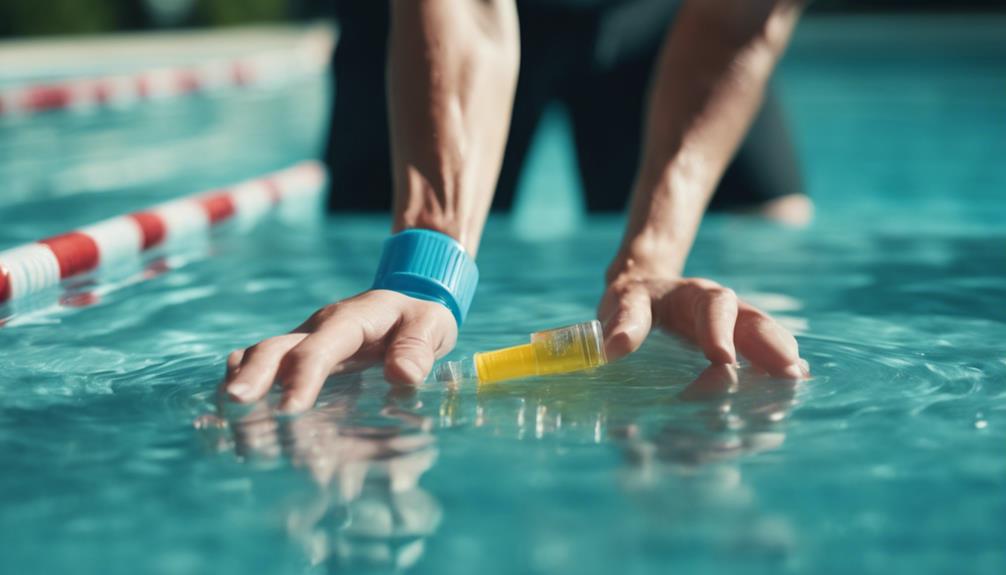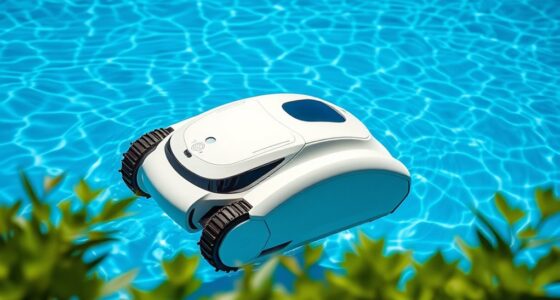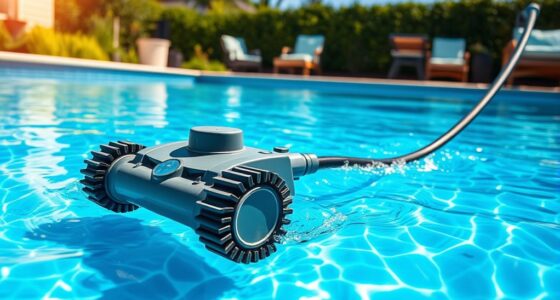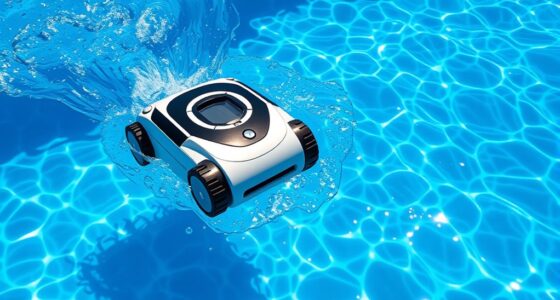Ready to maintain a safe and clear pool? Start by keeping pH levels between 7.4 and 7.6. Alkalinity is essential for stabilizing pH, so target a range of 80-120 ppm. Use test strips to ensure water accuracy and adjust alkalinity with baking soda. This cost-effective tip will help keep your pool balanced! Regular water testing and correct chemical usage are key to achieving a pristine pool. Baking soda is the affordable and effective solution you need. Discover the secrets of chemical balance for a safe oasis in your own backyard!
Key Takeaways
- Maintain pH between 7.4-7.6 for pool clarity.
- Keep alkalinity at 80-120 ppm for stable pH.
- Use baking soda to adjust alkalinity cost-effectively.
- Test pool water regularly for safety and balance.
- Baking soda aids in consistent pH levels affordably.
Importance of Proper Ph Levels
Visualize this: you immerse yourself in a pool with perfectly balanced pH levels, feeling rejuvenated and without a burning sensation in your eyes. That's the magic of maintaining the right pH balance.
When your pool's pH is between 7.4 and 7.6, it's like hitting the sweet spot for both you and the chemicals keeping your pool clean. This balance prevents corrosion, eye irritation, and even damage to your pool equipment. Plus, having a slightly alkaline pH level not only keeps your pool sparkling but also ensures that all the other chemicals work their best.
Imagine if your pool's pH levels were all over the place – it would be like attempting to bake a cake without the right ingredients. Fluctuating pH levels can throw off the effectiveness of sanitizers and other chemicals, making it harder to keep your pool safe and enjoyable.
Understanding Alkalinity in Pools
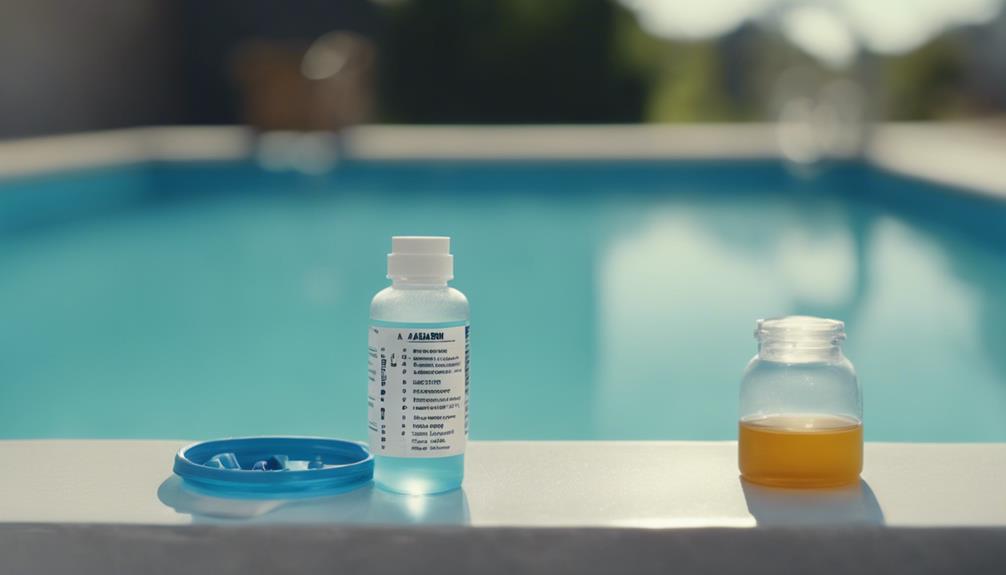
Hey there, pool owner! Let's talk about alkalinity, the unsung hero of pool chemistry.
Having the right alkalinity levels is like having a trusty sidekick for your pH levels, keeping them steady and balanced.
Testing and adjusting alkalinity might sound like extra work, but it's the secret sauce to crystal-clear water and happy swimmers.
Alkalinity Importance
Understanding the significance of alkalinity in pools is essential for ensuring water chemistry stability and peak performance of pool chemicals. Alkalinity acts as a superhero for your pool, keeping the pH levels in check and preventing them from going haywire. By maintaining alkalinity levels between 80-120 parts per million (ppm), you're basically giving your pool a solid foundation to work its magic.
Think of alkalinity as the sidekick to your chlorine and other pool chemicals, making sure they work effectively to keep your pool water crystal clear and safe for swimming.
Moreover, having the right alkalinity levels can also protect your pool equipment and surfaces from corrosion, extending their lifespan. So, it's like a win-win situation – your pool stays healthy, and your pool gear stays happy.
Monitoring and adjusting alkalinity might sound like a hassle, but trust me, it's a small price to pay for that perfect pool oasis you've always dreamed of.
Testing Alkalinity Levels
To effectively monitor the alkalinity levels in your pool, using test strips is a vital method for accurate measurement. These strips are easy to use and provide quick results, giving you a good indication of your pool's chemical balance.
Here are three key points to remember when testing your pool's alkalinity levels:
- Buffering pH: Alkalinity in your pool water acts as a buffer for pH levels. By maintaining the correct alkalinity levels, you help stabilize the pH, preventing it from swinging wildly and ensuring your pool's water remains balanced.
- Ideal Range: The proper alkalinity levels for your pool typically fall between 80-120 ppm. This range provides the stability needed to support other chemical balances in your pool effectively.
- Preventing Fluctuations: Alkalinity plays an essential role in preventing rapid pH fluctuations. Keeping your pool's alkalinity in check helps maintain a consistent pH level, which is essential for the overall health and clarity of your pool water.
Adjusting Alkalinity Levels
When it comes to adjusting alkalinity levels in your pool, understanding the role of alkalinity as a buffer for pH levels is essential. Alkalinity helps prevent wild swings in pH, keeping your pool water balanced and crystal clear.
Aim for an alkalinity range of 80-120 ppm for best pool water clarity and chemistry stability. If your alkalinity levels are too low, consider using baking soda as a cost-effective solution to raise them.
By maintaining proper alkalinity levels, you're ensuring that your pool water remains safe and comfortable for swimming.
Testing your alkalinity accurately is vital for getting the right balance. Remember, a well-balanced pool not only looks inviting but also helps protect your pool equipment and surfaces.
Effective Use of Test Strips

For accurate measurements of alkalinity levels in your pool water, effectively using test strips is crucial. When it comes to maintaining proper water balance, these strips are your best allies.
Here's how to make the most out of them:
- Check Expiration Dates:
Always make sure your test strips aren't expired. Using outdated strips can give you inaccurate readings, making it challenging to balance your pool water effectively.
- Follow Instructions Carefully:
Pay close attention to the instructions provided with the test strips. Proper technique ensures precise results, guiding you to make the necessary adjustments for the best water balance.
- Regular Testing Routine:
Establish a routine for testing your pool water using the strips. Consistent monitoring allows you to stay on top of your alkalinity levels, maintaining a balanced pH and ensuring your chlorine works effectively to keep your pool crystal clear.
Adjusting Alkalinity for Balance
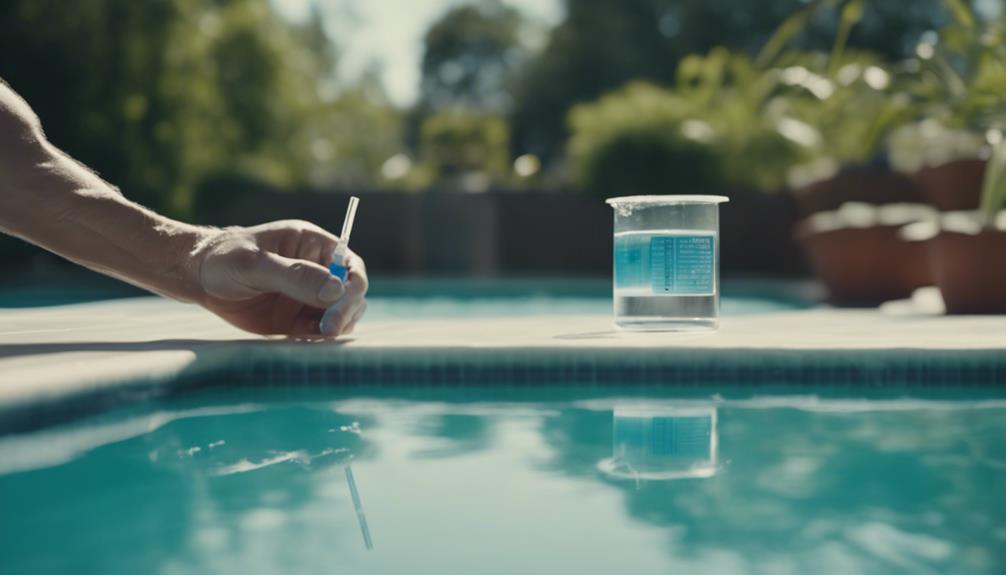
So, let's talk about adjusting alkalinity for a balanced pool.
You see, having the right alkalinity levels is like having a superhero shield for your pool's pH balance.
When you keep alkalinity between 80-120 ppm, you're setting the stage for clear water and happy swimmers.
Let's get into why alkalinity matters and how you can tweak it just right for a perfect pool paradise!
Alkalinity Importance Explained
Maintaining proper alkalinity levels in your pool is essential for guaranteeing a stable and balanced water chemistry. Balancing alkalinity is like having a trusty sidekick that keeps the pH levels in check, preventing them from going haywire.
Here are a few key points to help you understand the importance of alkalinity:
- Stability: Alkalinity acts as a buffer, preventing sudden swings in pH levels, which can impact water clarity and the efficiency of sanitizers like chlorine.
- Optimal Range: Keeping alkalinity levels between 80-120 ppm ensures that your pool water remains stable and comfortable for swimming, making maintenance a breeze.
- Chemical Efficiency: Proper alkalinity not only supports the effectiveness of chlorine but also helps other pool chemicals work their magic, guaranteeing your pool stays safe and crystal clear.
Methods for Adjustment
Adjusting the alkalinity levels in your pool is a straightforward process that plays an essential role in maintaining balanced pH levels and ensuring a safe swimming environment. When it comes to keeping your pool water in check, alkalinity is key! Baking soda is like a superhero for your pool – cost-effective and efficient at raising alkalinity levels. Just follow the instructions on the baking soda bags to know exactly how much to add for that perfect balance. Imagine your pool as a baking masterpiece, and the baking soda as the secret ingredient that makes it all come together!
Here's a handy table to help you understand the importance of adjusting alkalinity:
| Aspects | Importance |
|---|---|
| Stable pH | Prevents fluctuations |
| Balanced Chem | Ensures safety |
| Baking Soda | Cost-effective remedy |
Budget-Friendly Solutions With Baking Soda

Utilizing baking soda as a budget-friendly solution in balancing your pool's alkalinity can lead to stable pH levels and cost savings. Baking soda isn't just for baking cookies; it can also work wonders for your pool maintenance routine. Here's why you should consider this wallet-friendly hack:
- Cost-Effective: Baking soda is a fraction of the cost of specialized pool chemicals, making it a wallet-friendly option for keeping your pool in top shape.
- Stable pH Levels: Adjusting alkalinity with baking soda helps maintain a consistent pH level, ensuring your pool water stays crystal clear and safe for swimming.
- Easy Application: The instructions on baking soda bags are clear and straightforward, making it a breeze to use. Simply sprinkle it gradually around the pool edge for best results.
Consistent Water Testing Practices

To guarantee your pool remains safe and clear, consistent water testing practices are essential. Regularly testing your pool water helps you maintain the right chemical balance. By checking levels like pH, alkalinity, and chlorine, you make certain that your pool is a healthy environment for swimming.
Accurate water testing is like a superhero cape, warding off algae growth, protecting your equipment, and keeping swimmers happy and comfortable.
Consistency is key when it comes to water testing practices. Making sure to test your pool water regularly allows you to make reliable adjustments to keep everything in check. It's like giving your pool a little love and attention each time you test the water.
By following a routine testing schedule, you can catch any imbalances early and address them promptly. Think of it as being your pool's personal detective, solving mysteries and maintaining that crystal-clear water you love.
Diligent Chemical Usage Instructions

For precise chemical balance in your pool, it's crucial to diligently follow manufacturer instructions for accurate measurements and application methods. Here are three key tips to help you maintain ideal chemical balancing in Broward and prevent algae growth:
- Measure Accurately:
Always use the recommended measuring tools provided by the manufacturer to make certain you're adding the correct amount of chemicals to your pool water. Even small deviations can impact the overall balance and effectiveness of the treatment.
- Follow Dosage Recommendations:
Adhere strictly to the recommended chemical dosages to avoid over or under-treating your pool water. Consistency in applying the right amounts of chemicals will help prevent algae growth and other water quality issues.
- Proper Storage:
Store your pool chemicals in a cool, dry place away from sunlight and moisture. Proper storage not only extends the shelf life of the chemicals but also ensures their effectiveness when added to the pool water.
Benefits of Keeping Baking Soda Handy

Maintaining ideal chemical balance in your pool can be further enhanced by the benefits of keeping baking soda handy. Baking soda isn't just for baking cookies; it's a cost-effective secret weapon for keeping your pool water crystal clear!
Those handy instructions on the baking soda bags? They're like your pool water's best friend, guiding you on the perfect amount to use for a well-balanced pool. Plus, having baking soda on standby means you can tackle any water issues quickly and without breaking the bank.
Forget those overpriced alternatives at pool stores; baking soda is your wallet's best friend when it comes to water balance. For top-notch results, try sprinkling baking soda gradually around the pool's edge – it's like giving your pool a little sprinkle of magic for that perfect water balance.
Frequently Asked Questions
What Chemical Keeps Swimming Pool Sanitary and Safe?
The chemical that keeps your swimming pool clean and safe is chlorine. It's like the superhero that fights off bacteria and stops algae from taking over your pool party.
By keeping chlorine levels between 1-3 ppm, you're ensuring a healthy swimming environment for you and your friends.
Don't forget those shock treatments to zap away contaminants and keep your pool water crystal clear.
Proper chlorine management is key to a sparkling pool all summer long!
How to Make Your Swimming Pool Crystal Clear?
To make your swimming pool crystal clear, start by testing and adjusting pH, alkalinity, and chlorine levels regularly. This helps prevent algae and cloudy water, keeping your pool sparkling.
Shock treatments and algaecides can zap contaminants. Monitor calcium hardness and cyanuric acid levels for overall clarity.
Stick to a routine of skimming, brushing, and vacuuming to maintain a crystal-clear swimming oasis. Remember, a little TLC goes a long way in pool perfection!
In What Order Should I Balance My Pool Chemicals?
To balance your pool chemicals, start by adjusting alkalinity levels first. This sets a stable base for the rest.
Proper alkalinity (80-120 ppm) prevents wild pH swings. It helps chlorine work better too. By tackling alkalinity before pH, you make pH adjustments smoother.
Baking soda is a budget-friendly way to keep alkalinity in check. So, prioritize alkalinity for a safe and clear swimming pool!
How Do You Fix a Chemical Imbalance in a Pool?
When tackling a pesky chemical imbalance in your pool, start smart by testing the water with a reliable kit.
Adjust alkalinity first to steady that pH rollercoaster, making chlorine and shock treatments more potent.
Battle imbalance blues with baking soda; it's a budget-friendly hero! Sprinkle it gradually along the pool's edge for even spread.
Keep up with regular testing to dodge costly chaos and keep your pool sparkling like a gem!
What Chemicals Should I Use to Maintain a Crystal-Clear Pool?
To maintain a crystal-clear pool, use pool chemicals like chlorine, algaecide, and pH balancers. Regularly scrub and vacuum the pool, and brush the clean swimming pool glass fence. Test the water regularly to ensure proper chemical levels, and keep the pool filter clean to prevent buildup of debris and algae.
Conclusion
So, there you have it! By mastering the art of chemical balancing in your pool, you can guarantee a safe and sparkling oasis for all your summer fun.
Remember, maintaining your pH levels in check, adjusting alkalinity, and using baking soda can make a world of difference.
So grab those test strips, get mixing, and enjoy a crystal-clear pool all season long.
Happy swimming!

